Table of contents
- Factory report tire production at Dunlop The invention of the pneumatic tire
- The Dunlop center is in France
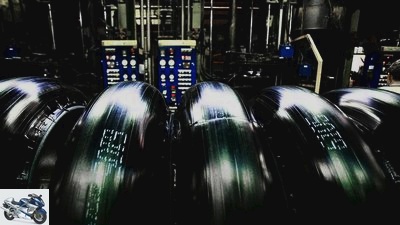
Dunlop
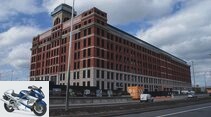
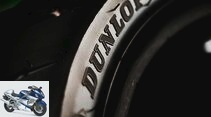
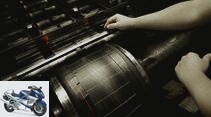

14th pictures
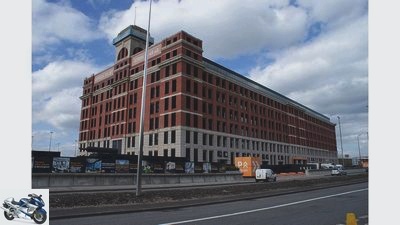
Dunlop
1/14
The Dunlop plant is located in Montluçon, France.
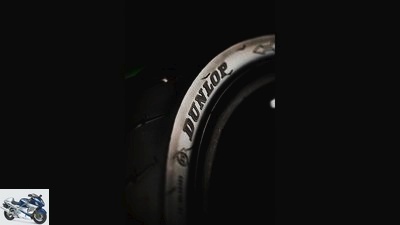
Dunlop
2/14
125 years after its premiere, the pneumatic tire still bears the name
of the inventor.
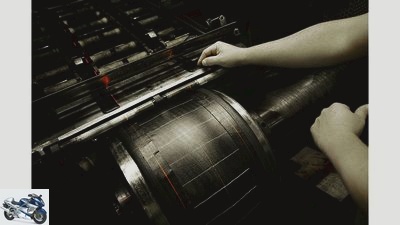
3/14
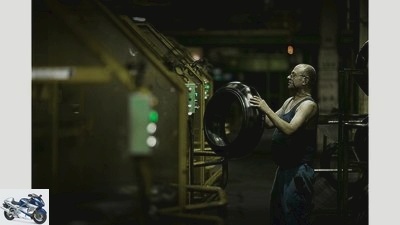
Dunlop
4/14
Shortly before baking, the blank already looks like a real motorcycle tire.
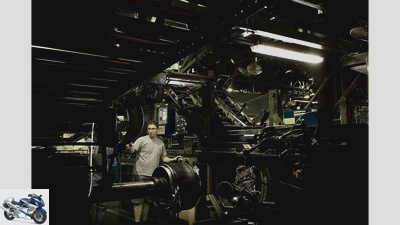
Dunlop
5/14
The hard wire core for the tire bead must be precisely positioned so that the tire sits firmly on the rim later.

2snap
6/14
or the current Moto2 World Championship, here with world champion Pol Espargaró.
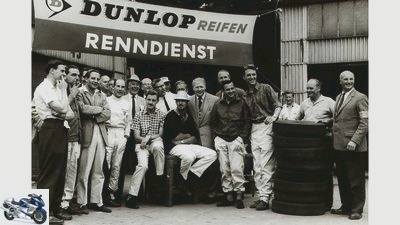
Dunlop
7/14
This is also the case with the Tourist Trophy on the Isle of Man…
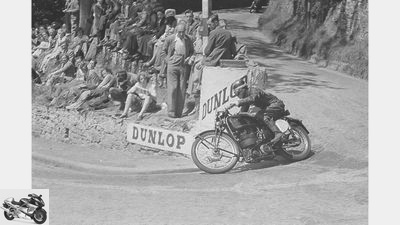
Dunlop
8/14
The history of Dunlop is closely linked to renowned racing series.
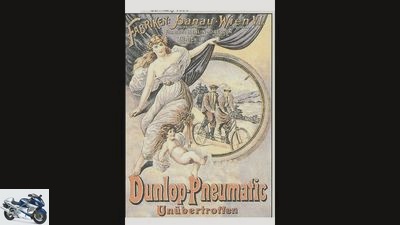
Dunlop
9/14
Nostalgic – a German Dunlop advertisement from the past.
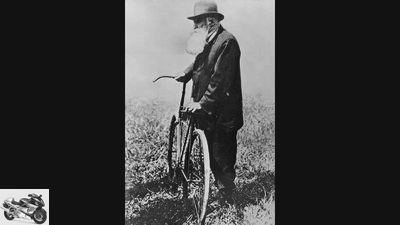
Dunlop
10/14
John Boyd Dunlop with a pneumatic bicycle, 1918.
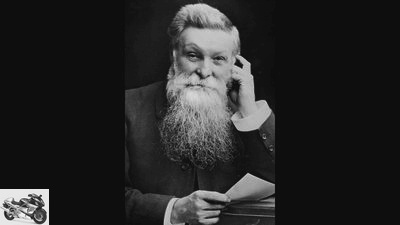
Dunlop
11/14
The Scot John Boyd Dunlop (1840–1921) is considered the father of the air-filled rubber tire.

Dunlop
12/14
The automobile should pick up speed with popular record attempts. Indispensable for this: suitable tires.
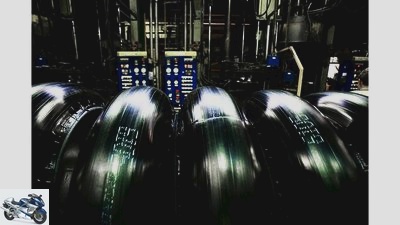
Dunlop
13/14
A lot has happened in tire manufacturing since it was founded in 1920.
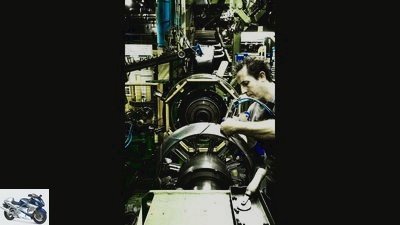
Dunlop
14/14
Manual work is always required when setting up the tools.
accesories
tire
Tire production at Dunlop
Factory report tire production at Dunlop
The invention of the pneumatic tire
More than 125 years ago, veterinarian John Boyd Dunlop put self-made pneumatic tires on his son’s tricycle. Tires still bear his name today. A lot has happened only in production.
Georg Jelicic
05.12.2013
Do you know how much stress a worn tire is? Of course, you have to get started now: find out which tire is probably the best for your bike, read tests, compare prices, remove wheels, run to the dealer, have them fitted … But let’s turn the wheel back a few more laps. A few thousand kilometers are now in the rubbers. In doing so, they had to put up with a lot in everyday life: they were tortured by longitudinal and lateral forces, and bumpy asphalt strips upset and squeezed them. They were exposed to frosty temperatures in spring and autumn and heated asphalt strips in midsummer. They survived all of this unscathed and always offered sufficient liability. On a surface that is just the size of a 20 cent coin. The black gold really has it all, but what else is behind it??
Buy complete article

Factory report tire production at Dunlop
The invention of the pneumatic tire
4 pages) as PDF
€ 2.00
Buy now
First the invention of the air-filled rubber tire by the Scot John Boyd Dunlop. That was 125 years ago now, and the advancement has definitely influenced mobility around the world. In the course of time, numerous innovations have been introduced for motorcycle tires: low profile tires, tubeless tires, radial tires … Dunlop even, it is said, his invention did not make him rich. But the company that bears his name continues to shape the tire business all over the world.

tire
6 pairs of touring tires in the test
Touring tires on Suzuki GSX-S 750
read more
The Dunlop center is in France
The tire plant in Montluçon, France, is the central point of contact for the development of Dunlop motorcycle tires. Incidentally, there is a nice anecdote about the founding in 1920: To meet the rapidly growing demand for tires, Dunlop was looking for new locations at the beginning of the last century. A suitable area had already been considered in the south of France. But on the way there, the steam locomotive quit its service – in the small town of Montluçon in Auvergne, of all places. During the repair, the Dunlop engineers took a look at the location and found that right here, in the middle of France, was the perfect location for the new tire plant. Whoever enters the factory today feels at first sight transported back this century. Machine monsters shape the halls, it stinks of rubber and solvents. But that’s only superficially.
Of course, there is still a lot of backbreaking work going into making a modern motorcycle tire. But in the meantime a lot of high-tech and precision devices determine the production processes in detail. Even in the manufacture of the synthetic rubber, the quality of which is permanently monitored by a laboratory directly attached to production. Since the synthetic rubber is also produced here in France for other Dunlop plants around the world, the consequences of any deviations from the production specifications would be fatal. Precision is also required when it comes to the construction of the carcass: For this purpose, the rubber is rolled out to the exact width and thickness using an oversized pasta dough machine, applied to a winding drum and stabilized with textile and kevlar inserts. Finally, the so-called “Jointless Belt” (JLB) process is used for reinforcement, in which a wire is precisely aligned in the running direction (“zero-degree belt”) onto the carcass. Further individual parts of the tire are assembled at the next stations. Inlays made of twisted steel wires form the bead of the tire, important for a firm fit on the rim.
Buy Dunlop tires at markt.motorradonline.de
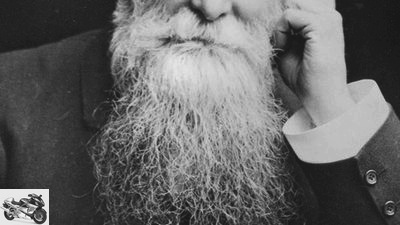
Dunlop
The Scot John Boyd Dunlop (1840–1921) is considered the father of air-filled rubber tires.
The carcass is finally assembled by hand. The bead cores are put over the carcass fabric, the edges are turned over and glued to the carcass. When the tire flanks are finally put on and the winding drum inflates the entire bandage vigorously, the proximity to a later motorcycle tire is unmistakable. A real highlight is the application of the tread: If the treads were previously laid on like a mat, the “Jointless Tread Process” (JLT) is now used, which is somewhat reminiscent of spraying cream on a delicious cake. By winding on tires with rubber compounds of different hardness (“multicompound”), the aim is to position them as precisely as possible on the tread. A process by which all racing tires for the Moto2 World Championship are also manufactured by an identical machine in Birmingham.
Finally, the tire is ready for vulcanization, during which the individual components of the motorcycle tire are connected to one another. To do this, the still soft tire is placed in a hot mold with a membrane on the inside. This membrane is filled with hot water and presses the tire into the mold at high pressure. The tire profile and the lettering on the sidewalls are created at the same time.
The vulcanization process takes about 20 minutes. Car tires only take ten minutes. But it is the complex structure and the high mechanical stress on motorcycle tires that require this long vulcanization process. 640 employees produce 3710 motorcycle tires in sizes from 13 to 21 inches per day. This corresponds to an annual production of over 1.3 million tires. And that is really no air act.
Related articles
-
M. Jahn, R. Gluck, Dunlop accesories tire PS knowledge: tire dictionary PS knowledge tire lexicon The ABC of tires Content of Tires aren’t just black and…
-
New Dunlop TT93 GP Pro tire for pit bikes
Dunlop accesories tire New Dunlop TT93 GP Pro tire for pit bikes Dunlop TT93 GP Pro Giant grip for mini racers Anyone who has rank and name in racing…
-
Buying tip tire test part 3 large enduro tires Dunlop Trailsmart
mps studio accesories tire Buying tip tire test part 3 large enduro tires Dunlop Trailsmart Best purchase tire test part 3 Dunlop Trailsmart Best choice…
-
Dunlop TT100 GP Radial: New Radial Retro Tire
Dunlop 3 pictures Dunlop 1/3 For the growing market of retro and heritage models, Dunlop is launching the Dunlop TT100 GP Radial, a new radial tire with…
-
Harley-Davidson Dunlop cooperation
Dunlop counselor traffic & business Harley-Davidson Dunlop cooperation Cooperation between Dunlop and Harley-Davidson 10 million tires in over 30 years…
-
The right tire choice for a motorcycle
Markus Jahn 26th pictures MOTORCYCLE 1/26 On the way on alpine passes? That’s how it works! MOTORCYCLE 2/26 Seductive winding curves with risk. The…
-
Sports tires in the 2013 tire test
Jahn 23 pictures Jahn 1/23 The 2013 MOTORRAD sports tire test. Jahn 2/23 The sports tires on the country road and motorway. Jahn 3/23 Where did the…
-
Tire age, inflation pressure, balancing
Marcus Jahn accesories tire Tire age, inflation pressure, balancing Tire age, tire pressure, tire balancing Motorcycle tires and their problems Even when…
-
What is the best motorcycle sports tire of 2015?
mps photo studio 11 pictures mps photo studio 1/11 The RS 10 is a very decent skin with many strengths and without significant weaknesses. Accordingly,…
-
PS reader question on motorcycle technology – tire wear on the racetrack
jkuenstle.de 5 pictures markus-jahn.com 1/5 “What is the reason for the flaky, frayed way in which racing tires are destroyed??”, asks us reader Holger…
Hello,
Im hoping you can help me. I am trying to find (with not much luck) a Dunlop 491 Elite II with raised white letters in the size of 150/90-18 .
THIS IS FOR A 1984 HONDA GL 1200 GOLDWING (LAST YEAR OF THE NAKED GOLDWING AND FIRST YEAR OF THE 1200- LESS THAN 5000 MADE)
IF YOU CAN STEER ME TO SCORING A NEW TIRE, ID BE VERY APPRECIATIVE,
Thank you,
David SImeoli
uca300m@yahoo.com
801-616-1200
Utah